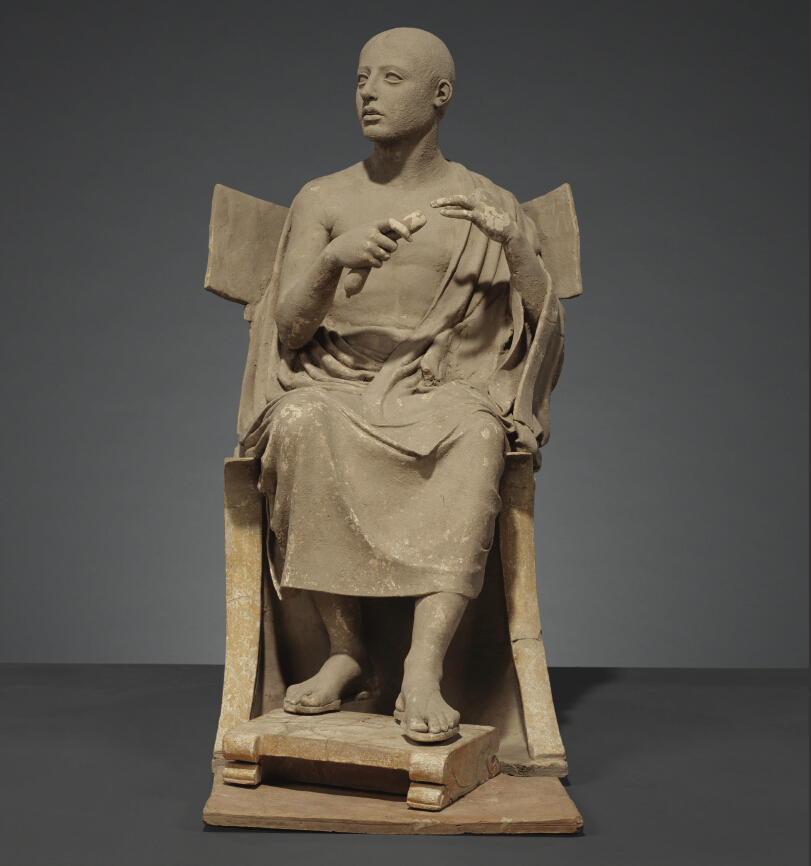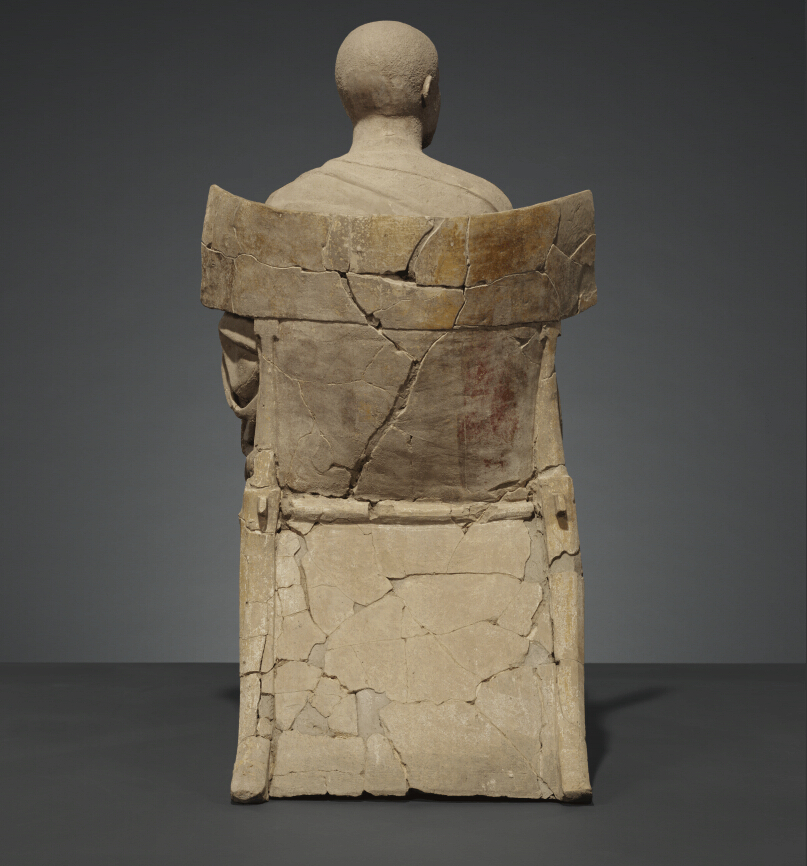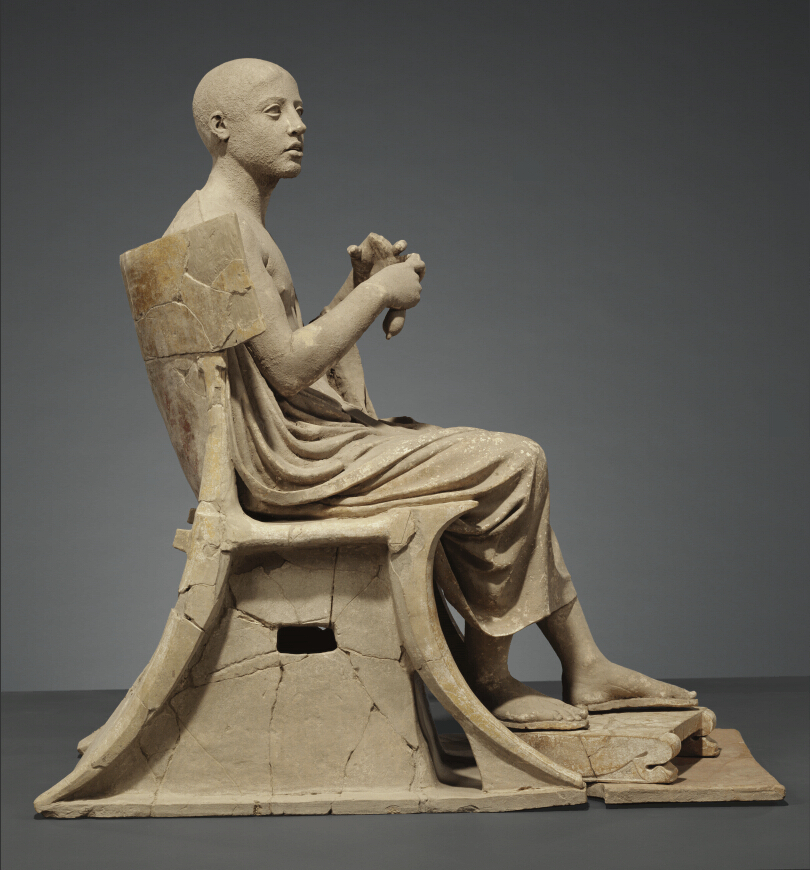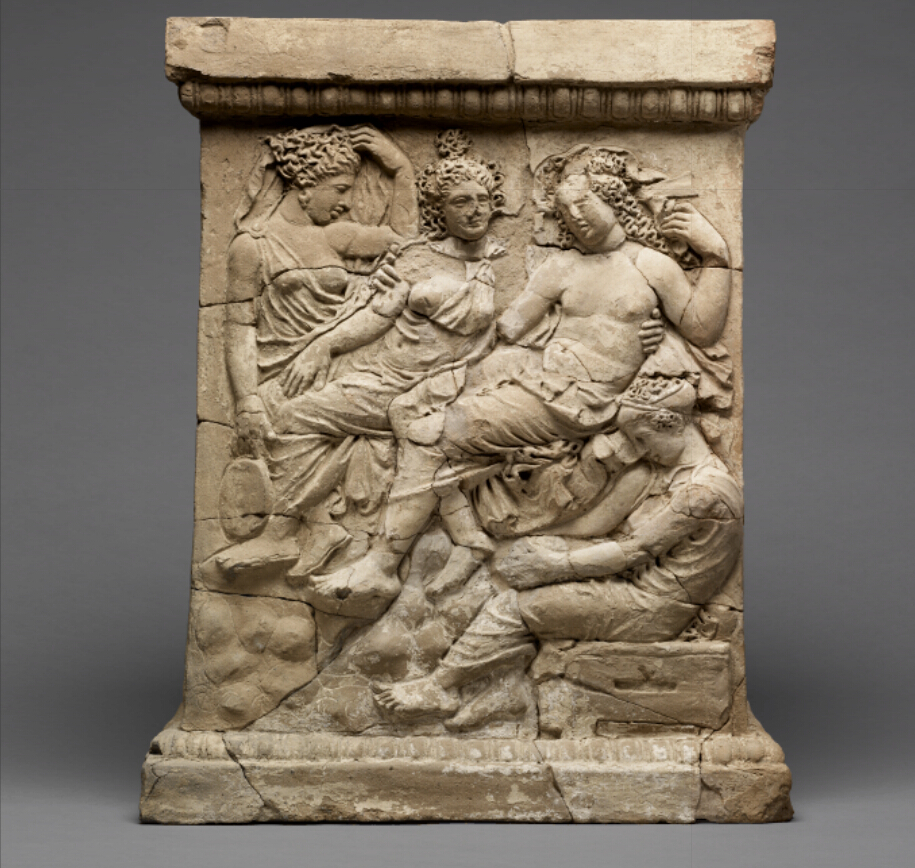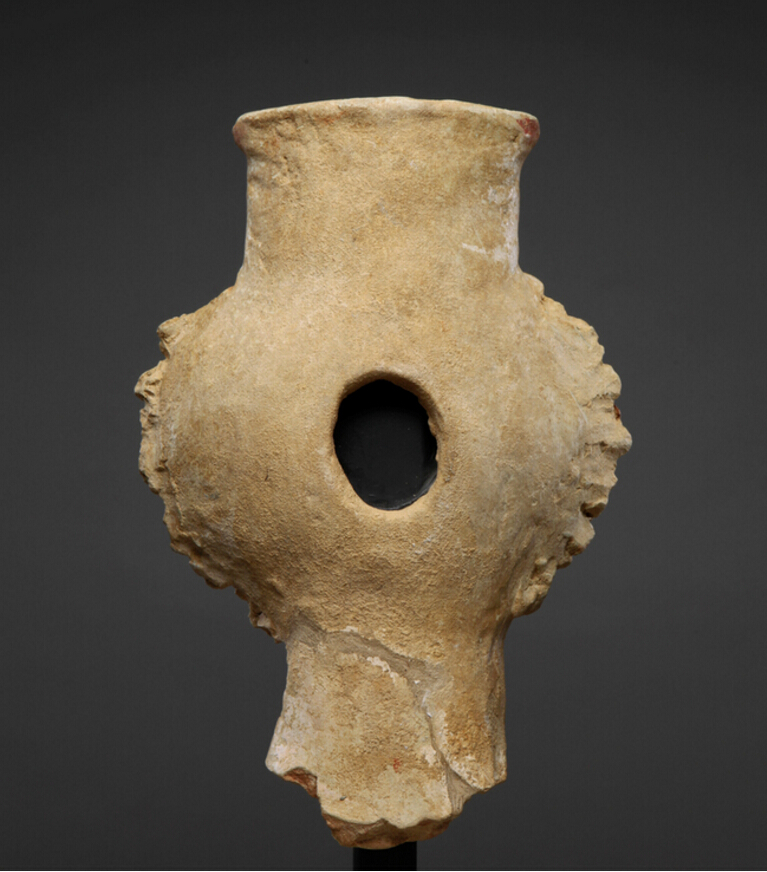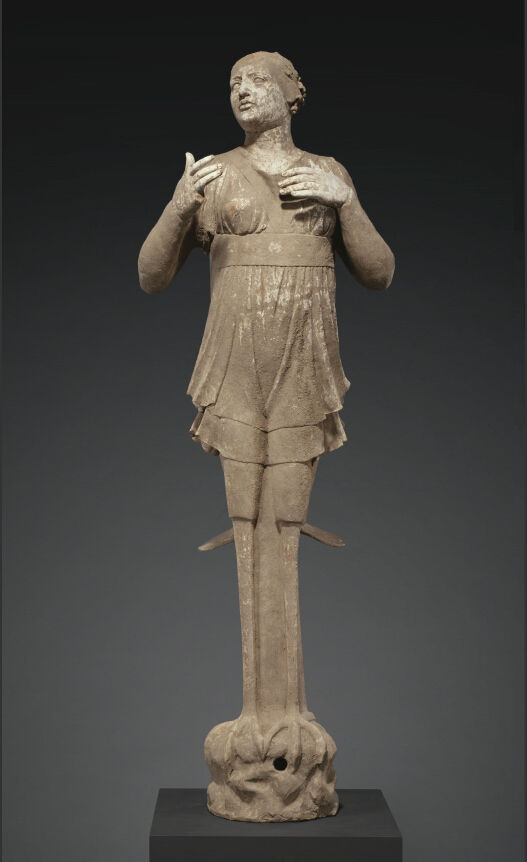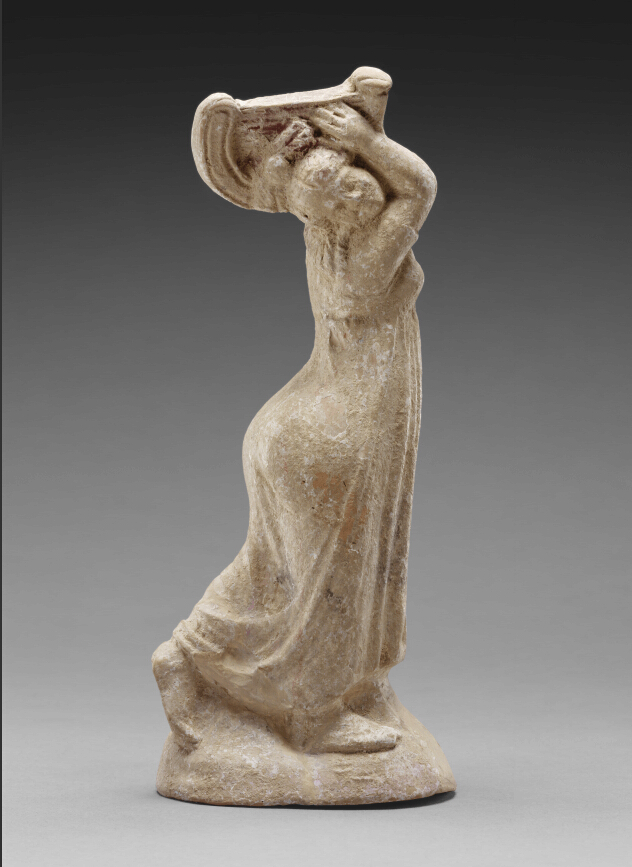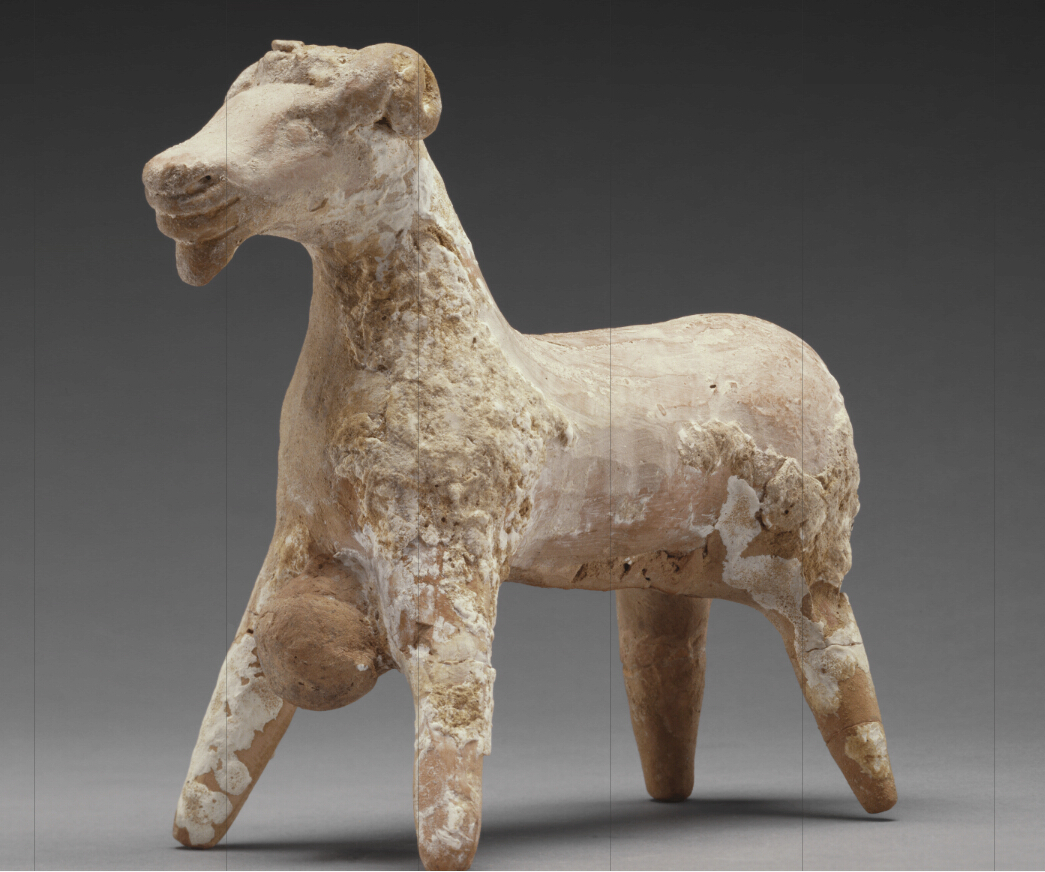DepthReading
ANCIENT TERRACOTTAS From south Italy and Sicily in the J.Paul Getty Museum
In the ancient world, terracotta sculpture
was ubiquitous. Readily available and economical—unlike stone suitable for
carving—clay allowed artisans to craft figures of remarkable variety and
expressiveness. Terracottas from South Italy and Sicily attest to the prolific
coroplastic workshops that supplied sacred and decorative images for
sanctuaries, settlements, and cemeteries. Sixty terracottas are investigated
here by noted scholar Maria Lucia Ferruzza, comprising a selection of
significant types from the Getty’s larger collection—life-size sculptures,
statuettes, heads and busts, altars, and decorative appliqués.
Statue of a Seated Poet
(Orpheus?)
330–300 BC
The male
figure is shown sitting on a klismos (seat). The seat, with a broad,
rounded backrest, is set on a low rectangular platform composed of two distinct
sections. The first section has a concave outer edge and is an integral part of
the chair, serving as its base; the second section is composed of a movable
element with a convex edge that fits flush and snug against the first section.
The rectangular openings on either side of the chair may have been used either
to lift the figure or to provide ventilation during firing.
The body
is wrapped in a mantle that covers his left shoulder and part of his left arm,
leaving his chest bare and showing wrinkles around the navel and the armpit.
The mantle drops on either side with deep folds, covering the figure’s legs to
the calves. The legs are slightly spread, so that the clay of the garment forms
thin, deep folds. The right foot rests on the footstool, while only the tip of
the left foot touches it. The figure is wearing flat sandals with thongs that
cross on the top of the feet. The footstool is made of a rectangular slab with
moldings and two lateral elements with a rounded shape, terminating in four
corbels.
The
figure’s head is erect and turned toward the right. The face is rounded; the
mouth, with its fleshy, carefully modeled lips, is partially open, revealing
the upper dental arch; a dimple marks the point where the lower lip meets the
prominent chin. The curling of the lower lip and the half-open mouth are both
signs that this character was probably portrayed in the act of singing. The
nose is straight, the nostrils are rounded, and the almond-shaped eyes have
distinctly portrayed eyelids, with clearly depicted tear glands. The
supraorbital arch, broad and close to the eye, runs directly into the upper
part of the nose. The hair must have been painted, as was determined by a
careful analysis of the nape of the neck, but it is possible that the head was
partially covered by a headdress, as the modeling of the upper part of the
forehead seems to suggest. The ears are well modeled.
The
right arm, its elbow resting against the torso, is bent, reaching forward to
hold a plectrum, while the left hand was probably plucking the strings of a
kithara. A trace of the instrument survives in the concavity where it must have
rested on the left leg.
The musical instrument and the middle finger
of the left hand are missing. The figure was reassembled from a number of
fragments prior to its acquisition by the J. Paul Getty Museum. The legs, the
head, and several sections of the himation were reattached. Missing sections
were filled in, especially on the chair in the area of the backrest and the
rear portion of the torso. During this interval, for which no specific
documentation exists, it is likely that invasive cleaning also damaged some of
the ancient polychromy. Recent investigations have helped clarify that the
obscuring encrustations were probably added at this time, especially on the
body and the head, in order to conceal break lines and areas of fill and to
give the figure a more uniform appearance overall. The interior of the statue
was also widely consolidated and reinforced with an added material, except in
several sections where the clay is still visible. As a result, there are only a
few places where the original marks of the modeling and the fingerprints of the
coroplast can be observed. In 1983 exploratory cleaning on a limited portion of
the footstool and chair was performed by the Getty’s Antiquities Conservation
Department, revealing some of the original polychromy and the presence of
footprints on the upper surface of the footstool.
Light
orange in color, slightly purified with more intense shade (Munsell 7.5 yr
8/3–8/5); the surface is covered by a white slip of calcium carbonate.
Preserved pigments.
Footstool (76.AD.11.4): Upper surface, sparse orange-gold pigment. The sides of the
footstool show a greater preservation of the orange-gold pigment layer as well
as some black pigment. The base (76.AD.11.5) has a reddish tone.
Chair: Little
pigment preservation on the sides; the legs were brightly colored in a
gold-yellow pigment; the center panel of the chair back is also a gold color,
similar to the legs, while the areas between the upper posts of the chair and
the panel were red, indicating Orpheus’s garment.
Orpheus: The head
reveals traces of two colors in two layers: a red color layer partially covered
with a layer of brown pigment. The drapery area is covered with a red pigment.
The skin is pink.
|
Location |
|
|
Orpheus with chair, footstool, and
slab (overall): H: 104 cm; W: 56.8 cm; D: 100.6 cm |
|
|
Footstool rest: H: 6.7 cm; W: 29.7 cm;
D: 24 cm |
|
|
Footstool rest, flat slab: H: 3 cm; W:
44.9 cm; D: 34.1 cm |
|
LATE FIFTH-EARLY FOURTH CENTURY BC
This altar and its pair, cat 47,
was reassembled from numerous fragments, and the polychromy is almost entirely
worn away. Before acquisition, they were probably subjected to an excessively
aggressive cleaning that abraded the surface at several points. Nevertheless,
large areas of a pale slip remain, over which traces of pigments can be seen.
Slight amounts of soil/carbonate incrustations are also visible, especially in
folds and details of the figures.
Reddish
in color (Munsell 10 r 6/6–8/6) with numerous micaceous, sandy, carbonous, and
calcareous inclusions of medium and large sizes; the clay is gray at the core.
Pigments were applied over a layer of yellowish diluted clay and white slip.
Red
(hair of the seated male figure in the center and of the female figure seated
on the cista), and green
pigment (drapery of the seated female figure in the middle).
|
ypology |
Altar |
|
Location |
|
|
Dimensions |
H: 41.8 cm; W (base): 33.4 cm; D
(base): 28.8 cm; W (top): 31.5 cm; D (top): 27.8 cm; W (hollow): 1.7 cm; D
(hollow): 2.7 cm |
Head of a Woman
350-300
BCA fragment of the back of the neck has been
reattached; the polychromy is worn away, and parts of the head and neck are
abraded.
Orange
in color (Munsell 2.5 yr 7/6–7/8), hard, fairly well purified, with reflective
and calcareous inclusions; a white slip and extensive traces of polychromy:
pink (face and neck); red (upper border of the polos, upper eyelid, and back
of the neck); dark pink (central part of the polos);
white and purple (lower border of the polos).
The
front section of the bust was made with a mold, and the details of the facial
features were defined with the use of a potter’s rib. The back section is not
modeled and has a slightly convex wall, with a large oval vent hole in the
center of the occiput.
|
Typology |
Head |
|
Location |
|
|
Dimensions |
H: 28.8 cm; W: 19.1 cm; Diam (polos):
12.2 cm |
Others...
Statue of a Standing Siren A
330–300 BC
Category: English
DepthReading
Key words:

